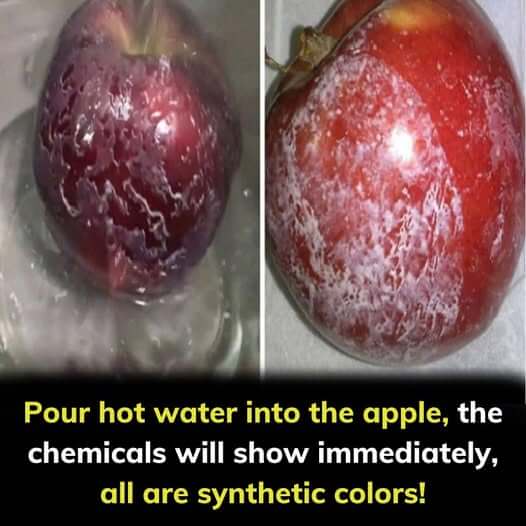Did you know that a simple trick with hot water can reveal if your apple is coated with harmful chemicals? It’s a quick and eye-opening way to check if the fruit on your table is truly safe.
- Why does pouring hot water on an apple expose harmful coatings?
Most apples are sold with a layer of wax on the skin. By pouring freshly boiled water over an apple, you can see whether that wax contains questionable preservatives. After a moment, the wax begins to appear, revealing that the apple may have been treated with substances that aren’t good for your health.
- How does wax on apples affect your body?
Apples are praised for being packed with vitamins and nutrients, making them a daily staple in many healthy diets. However, experts have raised concerns about apples sold in today’s markets, as many are coated with artificial wax and preservatives.
Naturally, apples already have a thin layer of wax that protects them. But to extend storage life and improve appearance, growers and retailers often apply an additional coating. While some companies use natural waxes like beeswax, carnauba wax, or plant resins—which are safe but costly—others turn to cheaper synthetic options. These coatings may contain fungicides, preservatives, and artificial dyes to keep apples looking shiny and attractive for weeks.
The problem? Industrial waxes and dyes have been linked to health concerns such as memory issues, weakened immunity, and respiratory problems. Although the connection between wax-coated apples and cancer is still debated, the risks cannot be ignored.
- How can you remove wax from apples before eating?
Since there’s no guarantee that apples bought at markets are coated with natural wax, especially if their price is average, it’s smart to take precautions. Here’s a simple method to clean them:
Step 1: Place the apples in a bowl with one spoon of baking soda, one tablespoon of lemon juice, and a little warm water.
Step 2: Roll the apples gently in the mixture, then use a soft toothbrush to scrub the skin carefully. This helps loosen and remove most of the wax coating.
For extra safety, it’s best to peel the apples before eating, even after cleaning.
- How to buy and store apples safely
- Always choose apples from trusted sources, such as branded import stores or large supermarkets. Avoid buying from unverified street vendors or stalls where the origin is unclear.
- Wash apples thoroughly before peeling if you plan to eat them right away. After peeling, to prevent browning, soak apple slices in warm water mixed with a little lemon juice. This keeps them fresh and colorful for hours.
- If you want to store apples for several days, wrap them in perforated plastic bags, seal them, and refrigerate.
Important note: Many imported apples, especially those from China, often look perfectly round with smooth, glossy skin and are wrapped in foam mesh. Once the mesh is removed, you may notice fine white particles or thin, film-like layers on the skin—these are signs of chemical preservatives evaporating and condensing.
By learning how to detect and properly clean apples, you can protect your family’s health and still enjoy this nutrient-rich fruit with peace of mind.”
